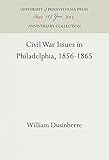Civil War Issues in Philadelphia, 1856-1865 / William Dusinberre.
Material type: TextPublisher: Philadelphia : University of Pennsylvania Press, [1965]Copyright date: ©1965Description: 1 online resource (200 p.)Content type:
TextPublisher: Philadelphia : University of Pennsylvania Press, [1965]Copyright date: ©1965Description: 1 online resource (200 p.)Content type: - 9781512811353
- 9781512815672
- 974.811
- F158.44 .D8 1965
- online - DeGruyter
| Item type | Current library | Call number | URL | Status | Notes | Barcode | |
|---|---|---|---|---|---|---|---|
 eBook
eBook
|
Biblioteca "Angelicum" Pont. Univ. S.Tommaso d'Aquino Nuvola online | online - DeGruyter (Browse shelf(Opens below)) | Online access | Not for loan (Accesso limitato) | Accesso per gli utenti autorizzati / Access for authorized users | (dgr)9781512815672 |
Frontmatter -- Acknowledgment -- Contents -- Introduction -- Prologue: Philadelphia -- 1. Party Views in 1856 -- 2. Abolitionism and the Fugitive Slave Question -- 3. The Territorial Question and the Democratic Party -- 4. John Brown’s Raid -- 5. Secession -- 6. Dissenters, Slaves, and Volunteers -- 7. Democrats, Negroes, and Conscripts -- 8. Conclusion -- Index
restricted access online access with authorization star
http://purl.org/coar/access_right/c_16ec
Philadelphia, before the Confederate bombardment of Fort Sumter, was not simply a "Northern" city. Unlike proslavery Washington but also unlike antislavery Boston, Philadelphia lay in the "Northern border area," where mixed sympathies led to divided loyalties and to frequent convulsions over the great issues that preceded the war. In Civil War Issues in Philadelphia, 1856-1865, author William Dusinberre examines three traditional interpretations of the war and shows how each has to be modified to fit Philadelphia's experience. In Part I he portrays the fundamental Philadelphia attitudes as they appeared in 1856 and the two main controversies--the fugitive slave question and the territorial issue--as they developed until 1858. Part II is devoted to the John Brown affair and the secession crisis. Part III analyzes wartime issues: the treatment of dissenters, the Negro question, and the recruitment of short-term soldiers when Confederate armies approached Pennsylvania. From this investigation emerges a vivid portrait of the North's second greatest city and its leading citizens--racist sympathizers with the South, cautious conciliators, firm conservatives, unconstrained anti-Southerners, outnumbered idealists--contending with the crisis of the Civil War periods.
Mode of access: Internet via World Wide Web.
In English.
Description based on online resource; title from PDF title page (publisher's Web site, viewed 26. Aug 2020)


